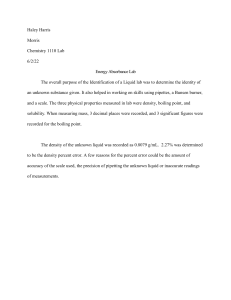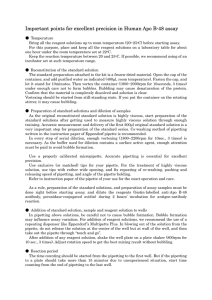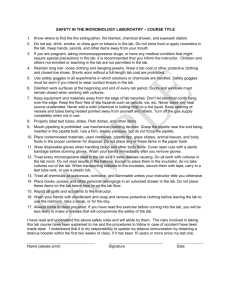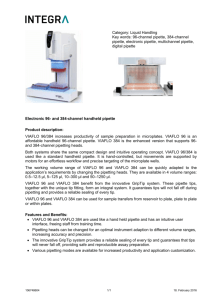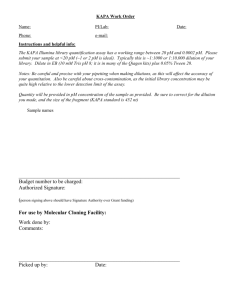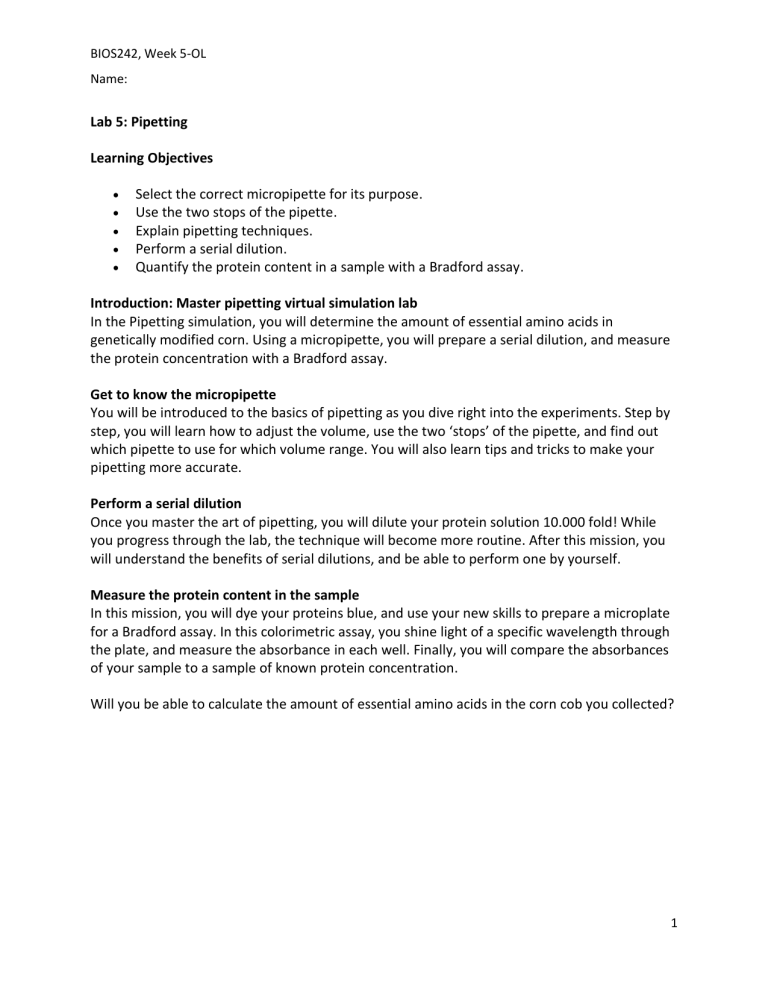
BIOS242, Week 5-OL Name: Lab 5: Pipetting Learning Objectives Select the correct micropipette for its purpose. Use the two stops of the pipette. Explain pipetting techniques. Perform a serial dilution. Quantify the protein content in a sample with a Bradford assay. Introduction: Master pipetting virtual simulation lab In the Pipetting simulation, you will determine the amount of essential amino acids in genetically modified corn. Using a micropipette, you will prepare a serial dilution, and measure the protein concentration with a Bradford assay. Get to know the micropipette You will be introduced to the basics of pipetting as you dive right into the experiments. Step by step, you will learn how to adjust the volume, use the two ‘stops’ of the pipette, and find out which pipette to use for which volume range. You will also learn tips and tricks to make your pipetting more accurate. Perform a serial dilution Once you master the art of pipetting, you will dilute your protein solution 10.000 fold! While you progress through the lab, the technique will become more routine. After this mission, you will understand the benefits of serial dilutions, and be able to perform one by yourself. Measure the protein content in the sample In this mission, you will dye your proteins blue, and use your new skills to prepare a microplate for a Bradford assay. In this colorimetric assay, you shine light of a specific wavelength through the plate, and measure the absorbance in each well. Finally, you will compare the absorbances of your sample to a sample of known protein concentration. Will you be able to calculate the amount of essential amino acids in the corn cob you collected? 1 BIOS242, Week 5-OL Name: Questions: 1. Purpose: Why is proper pipetting important in a microbiology lab? Proper pipetting is crucial in a microbiology lab for several reasons. Accurate and precise pipetting ensures that the correct volumes of reagents are added, which directly impacts the reliability and validity of experimental results. Inaccurate pipetting can lead to errors in concentrations, dilutions, and measurements, affecting the overall outcome of experiments. Additionally, in microbiology, even small variations in reagent volumes can impact microbial growth, enzyme reactions, and other biological processes being studied. Proper pipetting techniques also help prevent cross-contamination between samples, which is particularly important when working with microorganisms that can proliferate easily. In essence, proper pipetting contributes to the integrity of experimental data and the overall quality of research conducted in the microbiology lab. 2. What are the three different types of pipettes that are commonly used in lab? Commonly used pipettes in the lab include: a. Micropipettes: These are used for measuring and transferring small volumes, typically ranging from microliters (μL) to milliliters (mL). b. Serological Pipettes: These are used for larger volume transfers, usually in the range of milliliters (mL). They are often used in tissue culture, immunology, and clinical chemistry applications. c. Pasteur Pipettes: These are fine, narrow pipettes used for transferring small volumes, often used in applications such as transferring bacterial cultures. 2 BIOS242, Week 5-OL Name: 3. List 4 safety features that you will need to follow when using pipette? When using a pipette, it's important to follow these safety features: a. Wearing Personal Protective Equipment (PPE): This includes wearing gloves and lab coats to prevent contact with potentially hazardous substances. b. Avoiding Mouth Pipetting: Never use your mouth to aspirate or dispense liquids. Pipetting bulbs or mechanical pipettors should be used to prevent exposure to chemicals and biological materials. c. Proper Pipetting Technique: Follow the manufacturer's instructions for using the pipette, including using the appropriate tips, engaging the two stops correctly, and avoiding air bubbles in the tip. d. Proper Disposal: Dispose of used pipette tips in designated biohazard waste containers to prevent contamination and potential exposure to hazardous materials. 4. Reflection: Write 5 sentences on what you learned from this simulation. What did you like and what was something that you would prefer not be a part of this simulation? In this simulation, I learned the fundamental techniques of pipetting, including adjusting the volume, using the two stops of the pipette, and selecting the right pipette for different volume ranges. The serial dilution exercise provided valuable insight into the benefits and process of creating dilutions for accurate measurements. The microplate setup for the Bradford assay was enlightening, demonstrating the colorimetric method for quantifying protein concentration. Appreciated the hands-on approach and the step-by-step guidance in the simulation, making it easy to follow. However, I would prefer it if the simulation included more interactive quizzes or challenges to reinforce the concepts and enhance engagement during the learning process. 3 BIOS242, Week 5-OL Name: Grading Rubric: Activity Deliverable Points Lab Report and Complete lab report and answer questions 15 Questions All Lab Deliverables Purpose (2 point) Questions (8 points) Reflection (5 points) Complete ALL lab work and lab report 15 4
